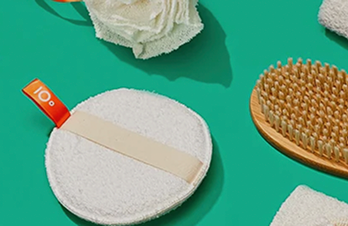Everyone desires a body with the smoothest and most radiant skin; fortunately, the secret to achieving this goal is more straightforward than people expect. Exfoliation is a surefire way to get the cleanest skin on your face, back, buttocks, chest, and even feet; it eliminates the dead skins from the surface as well as blemishes, breakouts, and more.
In the simplest terms, exfoliation brings the fresher and younger part of your skin to the surface by eliminating the dead cells that overwhelm it. This thick covering of waste skin, dirt, and oil clogs pores and leads to irritation, bumps, and other features that make the skin ugly.
However, exfoliation comes in different forms; physical and chemical exfoliation, and deciding which type is better requires thorough analysis. This article will shed more light on physical and chemical exfoliation to help you decide which is worth your while.
What is Physical Exfoliation?
Physical exfoliation is the act of rubbing or scrubbing off dead skin cells or particles with a physical exfoliant like sponges, body scrubs, brushes, muslin washcloth, and loofahs. This process keeps the skin healthy and fresh as the unnecessary layer is removed to allow moisture and ingredients to penetrate the skin.
It's worth noting that this form of exfoliation provides instant gratification as the face - or any other body part - feels smooth to the touch. Additionally, performing physical exfoliation aids blood circulation on the front, providing a rosy glow and eliminating damaged sections.
The Benefits of Physical Exfoliation
If you're familiar with physical exfoliants like body scrubs, you'd recognize that they are abrasive and rough, which is ideal for removing dead cells and dirt as you wash and scrub yourself.
Choosing to scrub in a circular motion around specific areas will improve the skin's elasticity, encourage blood flow, and reduce the amount of cellulite. Additionally, these products come with a pleasant fragrance and touting ingredients like sea salt, apricot, and walnut shells to promote healthier skin.
As previously mentioned, physical exfoliation shows results faster than chemical exfoliation as it uses force to remove the dead skin - painlessly - from your buttocks, face, or torso. They also have fewer chemicals that interact with your face and other skincare products in your beauty arsenal.
Problems with Physical Exfoliation
Despite its advantages, physical exfoliation comes with a few drawbacks, such as its adverse impact on delicate skins. When the rough and abrasive material forcefully rids the body of the waste cells, the sharpness may cause micro-tears on susceptible skins.
This drawback makes physical exfoliation a treatment that's best suited for individuals with thicker skin. If you find it difficult to deduce whether you have delicate or sturdy skin, consider conversing with your dermatologist before trying the physical option.
Another drawback is its effect on buttock issues like folliculitis, which is an inflammation of the hair follicles. Applying the sharp Exfoliant on them produces an irritation that worsens the problem.
Pros:
- Instant results
- Encourages blood circulation
- Eliminated dead cells and waste
- Improved the skin's elasticity
- It comes with a pleasant fragrance
Cons:
- Incompatible with delicate skins
- May complicate skin issues like folliculitis
What is Chemical Exfoliation?
The term "Chemical" is often viewed from a negative perspective as synthetic and harmful to the body. However, that perception is false in the world of exfoliation as chemical exfoliants work to weaken the bond between dead skin cells, allowing you to wipe them off.
Thanks to their composition, they feel smooth to the touch and possess no abrasive particles that may damage or irritate the individual during or after application. They mostly contain essential nutrients like fruit enzymes, Beta Hydroxy Acids (BHAs), and Alpha Hydroxy Acids (AHAs) to keep the skin healthy and dirt-free
The Benefits of Chemical Exfoliation
Although the term "chemical" may evoke some adverse reactions from people as it is often associated with toxicity, exfoliants in this category are incredibly safe to use and pose no negative effect.
Chemical exfoliants come in two types: Alpha Hydroxy Acids (AHAs) and Beta Hydroxy Acids (BHAs). The first compound is ideal for individuals with dehydrated skin as they work to weaken the bond that connects the dead skin to fresh ones.
On the other hand, Beta Hydroxy Acids (BHAs) are ideal for oily skin as they are perfect for penetrating deep into pores, making them ideal for people with acne issues. You can get both Beta Hydroxy Acids (BHAs) and Alpha Hydroxy Acids (AHAs) from a natural source like the citric acid in orange peels.
It's worth noting that these chemical exfoliants are effective for treating stubborn bumps, pimples, and other skin-related problems that hinder your beauty.
Problems with Chemical Exfoliation
Everything with an advantage naturally possesses a few disadvantages; the primary concern is the demerit's gravity. In chemical exfoliation, while the presence of Beta Hydroxy Acids (BHAs) and Alpha Hydroxy Acids (AHAs) guarantees beautiful skin, the time to experience results is lengthy.
In other words, the primary downside of using chemicals exfoliants is the time it takes to remove the dirt from your skin. This long wait is due to the compound separating the dead skin from the new cells, as the process isn't instantaneous.
Therefore, if you need to attend an occasion and desire instant results, physical exfoliation is your best option.
Pros:
- Ideal for delicate skins
- Presents no adverse effect
- Possess no abrasive component
- It comes with a variety of nutrients
Cons:
- It takes a long time to exfoliate the skin thoroughly
How to use chemical Exfoliate safely (Bonus)
Physical exfoliation is easy to understand as its requirements are straightforward; however, chemical exfoliants may appear confusing because of the numerous compounds it possesses.
To get the best out of this exfoliation option, consider the instructions below:
- Understand your skin type
- Avoid exfoliants that contain toxic, harmful, and unknown chemical
- Exfoliate a maximum of three times a week to see impressive results.
If you still are unsure of what chemical exfoliant is ideal for your skin, contact your dermatologist to be on the safer side and avoid complications.
Conclusion
In the end, both chemical and physical exfoliants help remove dead skin and reveal the youthful side of your body. However, physical exfoliants are relatively abrasive and may be incompatible with delicate skin; nevertheless, they provide instant results and eliminate the waste within minutes.
On the other hand, chemical exfoliants are suitable for delicate and sturdy skins as their compounds gently weaken the bond between dead skin cells, enabling you to wash them off and reveal the fresh side.
However, the results are not instantaneous and will take relatively more prolonged than physical Exfoliants to eradicate the waste surface. The choice is yours, but if you struggle
with choosing the correct option for you, consider consulting a dermatologist.
Cleanlogic Sustainable Exfoliating Body Gloves – Cleanlogic Body Care












0 comments